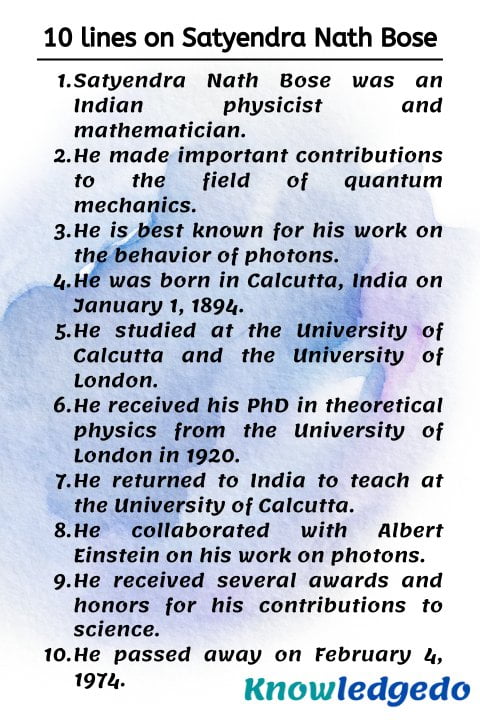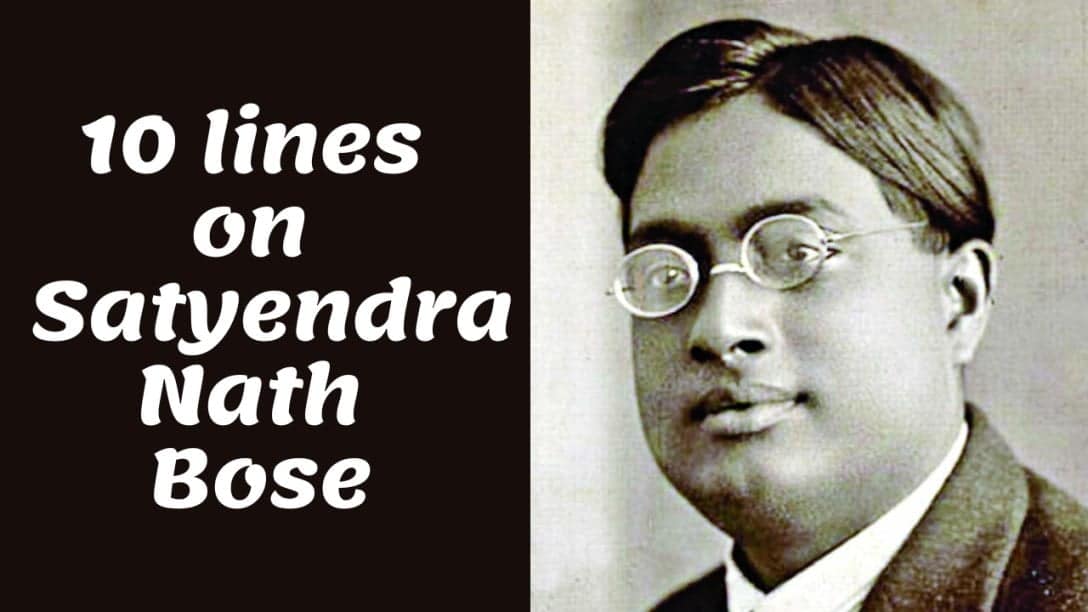Today, we are sharing 10 lines on Satyendra Nath Bose in English This article can help students who are looking for information about Satyendra Nath Bose. This essay is very simple and easy to remember. The level of this essay is moderate so any student can write on this topic.
This article is generally useful for class 1 to class 12
10 lines on Satyendra Nath Bose
1) Satyendra Nath Bose was an Indian physicist and mathematician.
2) He made important contributions to the field of quantum mechanics.
3) He is best known for his work on the behaviour of photons.
4) He was born in Kolkata, India on January 1, 1894.
5) He studied at the University of Kolkata and the University of London.
6) He received his PhD in theoretical physics from the University of London in 1920.
7) He returned to India to teach at the University of Kolkata.
8) He collaborated with Albert Einstein on his work on photons.
9)He received several awards and honours for his contributions to science.
10) He passed away on February 4, 1974.

10 lines on Satyendra Nath Bose
1) Satyendra Nath Bose was an Indian physicist and mathematician who made significant contributions to the field of quantum mechanics.
2) He is best known for his work on the theory of the behaviour of photons, which led to the development of the concept of Bose-Einstein statistics.
3) Bose was born in Kolkata, India on January 1, 1894.
4) He studied at the University of Kolkata, where he earned his Bachelor’s and Master’s degrees in mathematics.
5) He went on to earn his PhD in theoretical physics from the University of London in 1920.
6) After completing his education, Bose returned to India and joined the University of Kolkata as a professor of physics.
7) In 1924, he sent his theory on the behaviour of photons to Albert Einstein, who was impressed by his work and translated it into German.
8) The two scientists collaborated on further research and published a joint paper on Bose’s theory, which became known as Bose-Einstein statistics.
9) Bose also made significant contributions to the field of mathematical physics and was recognized with several awards and honours for his work.
10) He passed away on February 4, 1974, leaving behind a legacy as a pioneering scientist in the field of quantum mechanics.
5 Lines on Satyendra Nath Bose
1) Satyendra Nath Bose was an Indian physicist and mathematician.
2) He made important contributions to the field of quantum mechanics.
3) He is best known for his work on the behaviour of photons.
4) He received his PhD in theoretical physics from the University of London in 1920.
5) He passed away on February 4, 1974.
Also read: 10 Lines on Subhash Chandra Bose
Also read: 10 lines on Sarojini Naidu
FAQ
Satyendra Nath Bose was an Indian physicist and mathematician who made significant contributions to the fields of quantum mechanics and statistical mechanics. He was born in Calcutta, India, in 1894 and received his education at the University of Calcutta and the University of London. Bose is best known for his work on the Bose-Einstein statistics and the Bose-Einstein condensate, which are named after him and Albert Einstein.
Bose’s most famous work in quantum mechanics was his development of the Bose-Einstein statistics, which describe the statistical behavior of a system of identical particles. In 1924, he published a paper describing his work on the subject, which was later translated into German and published in the journal “Zeitschrift für Physik.” The Bose-Einstein statistics were later generalized by Einstein to describe the behavior of any system of identical particles, and they are now an essential part of the theory of quantum mechanics.
A Bose-Einstein condensate is a state of matter that occurs at extremely low temperatures, in which a group of particles behave as a single entity and exhibit unusual quantum mechanical properties. The concept of the Bose-Einstein condensate was first proposed by Bose and Einstein in the 1920s, but it was not until 1995 that the first Bose-Einstein condensate was created in the laboratory. Bose-Einstein condensates have been observed in a variety of systems, including atoms, molecules, and even photons, and they have important applications in fields such as quantum computing and precision measurement.
